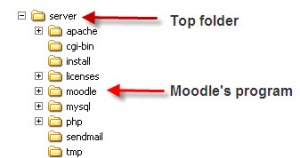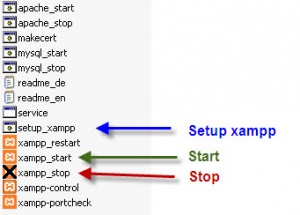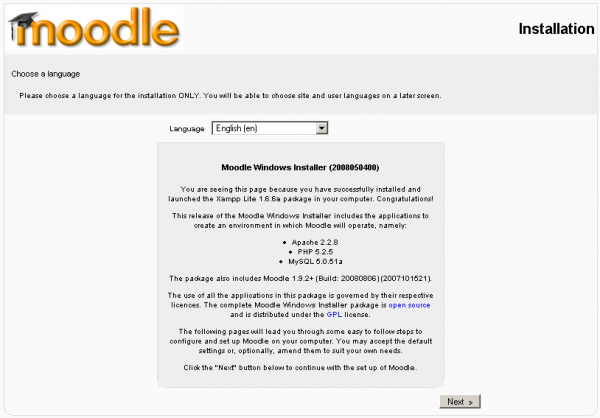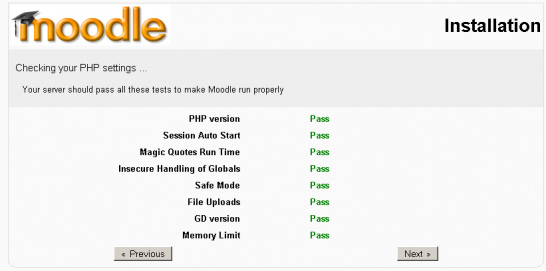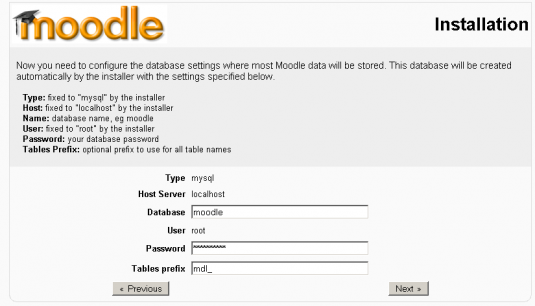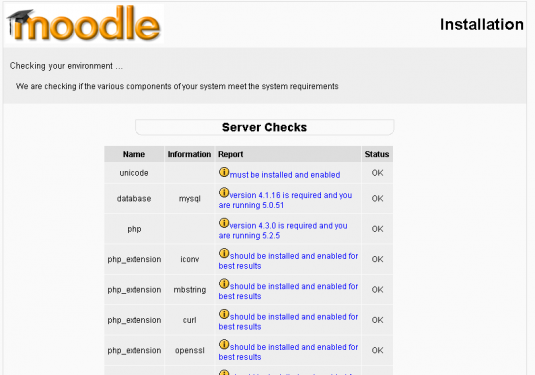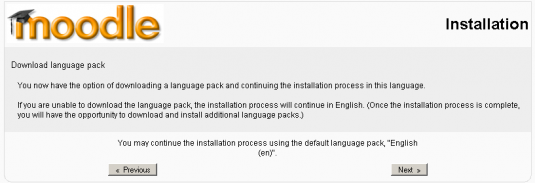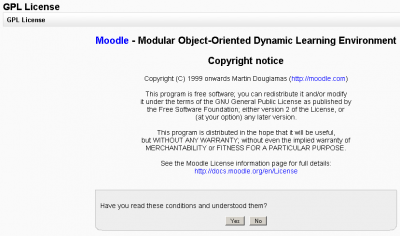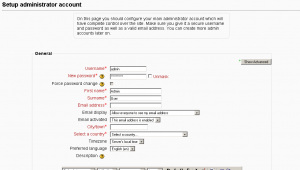Complete install packages for Windows: Difference between revisions
(→Start the Moodle installation: Changed images) |
(→Start the Moodle installation: captions and resize images) |
||
| Line 52: | Line 52: | ||
The initial install page will be displayed after you type "localhost". | The initial install page will be displayed after you type "localhost". | ||
[[Image:C Install Windows 1.png|thumb|center|600px| | [[Image:C Install Windows 1.png|thumb|center|600px|Set initial language]] | ||
*Choose your preferred language (English is used in this example) and click the “Next” button. | *Choose your preferred language (English is used in this example) and click the “Next” button. | ||
*A diagnostic report is displayed – hopefully it will look like this, if not you may need to address some issues. | *A diagnostic report is displayed – hopefully it will look like this, if not you may need to address some issues. | ||
[[Image:Complete Windows Install 2.png|thumb|center|546px]] | [[Image:Complete Windows Install 2.png|thumb|center|546px|Moodle liked and gave a Pass ]] | ||
| Line 64: | Line 64: | ||
*The paths for your Moodle installation are shown – accept the ones that are shown on your screen. | *The paths for your Moodle installation are shown – accept the ones that are shown on your screen. | ||
[[image:Complete install Windows 3.png|thumb|center| | [[image:Complete install Windows 3.png|thumb|center|600px|Installation paths]] | ||
| Line 79: | Line 79: | ||
*DO NOT USE THE “ROOT” USER WITHOUT A PASSWORD FOR PRODUCTION INSTALLATIONS AS THIS CREATES A SECURITY VULNERABILITY | *DO NOT USE THE “ROOT” USER WITHOUT A PASSWORD FOR PRODUCTION INSTALLATIONS AS THIS CREATES A SECURITY VULNERABILITY | ||
[[image:Complete install Windows 4.png|thumb|center|535px]] | [[image:Complete install Windows 4.png|thumb|center|535px|Installation's database settings]] | ||
*When the fields have been populated, click the “Next” button to continue. | *When the fields have been populated, click the “Next” button to continue. | ||
[[image:Complete install Windows 5.png|thumb|center|535px]] | [[image:Complete install Windows 5.png|thumb|center|535px|Check server environment screen]] | ||
[[image:Complete install Windows 6.png|thumb|center|535px]] | *Click the “Next” button to continue. | ||
Moodle will now check to see if the language pack is available for the language you selected at the first step. If it is not, Moodle will continue with the install in English. | |||
[[image:Complete install Windows 6.png|thumb|center|535px|Language pack check]] | |||
*Provided the Moodle folder is writable, a message confirming the configuration has been completed will be displayed. | *Provided the Moodle folder is writable, a message confirming the configuration has been completed will be displayed. | ||
[[image:Complete install Windows 7.png|thumb|center|549px]] | [[image:Complete install Windows 7.png|thumb|center|549px|Confirmation that config.php has been created]] | ||
*Click the “ Continue” button to proceed. | *Click the “ Continue” button to proceed. | ||
The Moodle copyright / | The Moodle copyright / license notices are displayed. | ||
[[image:Complete install Windows 8.png|thumb|center| | [[image:Complete install Windows 8.png|thumb|center|400px|Copyright notice and agreement]] | ||
| Line 101: | Line 103: | ||
*Click the "Continue" button and wait. | *Click the "Continue" button and wait. | ||
[[Image:Complete install Windows 9.png]] | [[Image:Complete install Windows 9.png|thumb|center|600px|Current release and "unattended" check box]] | ||
In most cases this will be followed by a series of screens that have a continue button on the bottom. This process stops with Admin user profile settings which needs to be filled out. | In most cases this will be followed by a series of screens that have a continue button on the bottom. This process stops with Admin user profile settings which needs to be filled out. | ||
| Line 111: | Line 113: | ||
The next screen is the Front Page settings page. There are two parts to it. | The next screen is the Front Page settings page. There are two parts to it. | ||
The first part will ask for your Full site name and a short name for the navigation bar. There is also a place for a description. You can change these later. | |||
[[Image:Complete install Windows | [[Image:Complete install Windows 11a.png|thumb|center|The Moodle sites [[Front Page]] information]] | ||
The second part on the bottom instructs Moodle if you will disable the new user self [[authentication]] through email process. The default is to disable. This can be changed later in the site administration block. | |||
[[Image:Complete install Windows 11ba.png|thumb|center|500px|Determine if users can create their own profiles when they log onto the side via email self authentication]] | |||
*Click on "Save changes" button to go to Moodle sites home page. | *Click on "Save changes" button to go to Moodle sites home page. | ||
'''Now you are ready to Moodle !''' | |||
[[Image:Complete install Windows 12.png|thumb|center|Blank Front page of your new site]] | [[Image:Complete install Windows 12.png|thumb|center|Blank Front page of your new site]] | ||
The Site Administration block is on the left, the "Turn edit on" button in the upper right corner, withe the site description block just below it. | |||
===Congratulations - Moodle has been installed=== | ===Congratulations - Moodle has been installed=== | ||
Revision as of 16:59, 7 August 2008
Complete install packages are available from Moodle Downloads, located on a tab for each of the operating systems. The packages are designed for new installations on a server or standalone computer. Please note the standard distributions only contain the Moodle code.
This document provides instructions for using the Windows packages. Separate instructions are available for Mac OS X packages.
For installation on a Windows 2000 or Windows 2003 server it is good practice to perform a manual install (see the manual installation section in Windows Installation).
After installing the Windows package, note that there are other downloads (e.g. additional modules and plugins) that may involve more customization of configuration files.
The complete install packages allow Moodle to be installed, along with the prerequisites that includes a web server, database and scripting language (Apache, MySQL and PHP in this case). Several versions of the complete install package are available. The instructions on the download page provide guidance on which version is likely to be most suitable.
Note: The latest complete install package version components, may not be backwardly compatible. Always check version compatibility of each component if you intend to develop materials on a later version of Moodle than the version installed on your "main" Moodle site. In short, complete install packages are designed for first time install on a "clean" machine.
System requirements
- 256 MB RAM (minimum), 512 MB RAM (recommended)
- 160 MB free Fixed Disk (more space will be needed depending on user uploads)
- Windows 98/ME (minimum)
- Windows NT/2000/XP (recommended)
Install complete package
As noted above the complete install package is a zip file that contains Moodle and programs to create a webserver called Apache, which will use MySQL and PHP.
First steps
Step 1: Download Windows packed-zip file from Moodle.
Step 2: Unpack (extract files by clicking on) the zip file you downloaded to a drive or partition of your choice. The extract process will create a folder called "server". For example, C:\server or W:\server or something like this. Pre 2008 version would create a folder called "moodle"
- It is a good practice at this point to rename the C:\server to something like C:\Moodle19 or C:\Web.
- Note: there will also be a folder under this top folder, called \moodle that holds the Moodle program.
Step 3: Using Window's explorer find and click on "setup_xampp.bat" in the top folder. This will configure Xammp and the webserver.
- Note: XAMPP makes no entries in the windows registry and no settings for the system variables.
Step 4: Now you are ready to start the webserver. Use the Xampp_start file which you should find in the top directory (for example C:\Moodle19). Once the Xampp_start program is open, don't close it, use Xampp_stop for that purpose.
- Xampp start and stop program(s) control both Apache and MySQL programs that operate the webserver. Some sites will individually start and stop Apache and MySQL with their bat files found in the top folder such as C:\Moodle19
- Or on a stand alone computer with several potential webservers that might be running, use the "restart".
- Put shortcuts to the commands that start and stop the site in your Windows "start" menu system.
Step 5: Now you are ready to start the Moodle installation.
Start the Moodle installation
Start your web browser and type localhost, or http://127.0.0.1 or http://localhost in the address bar. You will either start your first time Moodle installation or if it is already installed you will enter the Moodle site's Front Page or Login screen.
- Tip: after Moodle installs, put the site in your "favorites" or as a "bookmark" in you browser.
- Tip: after Moodle installs, put the site in your "favorites" or as a "bookmark" in you browser.
The initial install page will be displayed after you type "localhost".
- Choose your preferred language (English is used in this example) and click the “Next” button.
- A diagnostic report is displayed – hopefully it will look like this, if not you may need to address some issues.
- Click the “Next” button to continue.
- The paths for your Moodle installation are shown – accept the ones that are shown on your screen.
- Click the “Next” button to continue.
- What you enter in the "Host Server" field depends on what you intend to use the new Moodle installation for.
If you are just going to use it for local testing, then use 'localhost'. If you are going to test the new installation on a LAN, and will be accessing it from other machines on that LAN, then put the private IP address or network name of the serving machine, followed by a forward slash and moodle: Host Server - 192.168.1.1/moodle If you are going to test the installation on the internet, then you will need to put the public ip address followed by a forward slash and moodle: your_ip_address/moodle or you can put your domain name here instead.
- In the next fields, we enter the database settings. The fields are populated with some suggested values.
- We strongly recommend you place a user name and password in this screen. (Don't forget them).
- DO NOT USE THE “ROOT” USER WITHOUT A PASSWORD FOR PRODUCTION INSTALLATIONS AS THIS CREATES A SECURITY VULNERABILITY
- When the fields have been populated, click the “Next” button to continue.
- Click the “Next” button to continue.
Moodle will now check to see if the language pack is available for the language you selected at the first step. If it is not, Moodle will continue with the install in English.
- Provided the Moodle folder is writable, a message confirming the configuration has been completed will be displayed.
- Click the “ Continue” button to proceed.
The Moodle copyright / license notices are displayed.
- Click the “Yes” button to continue.
The current release information is shown. Check off the unattended operations box. This will automatically advance through many screens. If you would like to watch the install screen by screen, do not check this box and be prepared to press the "continute button" many times.
- Click the "Continue" button and wait.
In most cases this will be followed by a series of screens that have a continue button on the bottom. This process stops with Admin user profile settings which needs to be filled out.
Fill out the required fields.
- Click on "Save" to continue
The next screen is the Front Page settings page. There are two parts to it. The first part will ask for your Full site name and a short name for the navigation bar. There is also a place for a description. You can change these later.
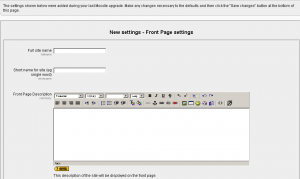
The second part on the bottom instructs Moodle if you will disable the new user self authentication through email process. The default is to disable. This can be changed later in the site administration block.
- Click on "Save changes" button to go to Moodle sites home page.
Now you are ready to Moodle !
The Site Administration block is on the left, the "Turn edit on" button in the upper right corner, withe the site description block just below it.
Congratulations - Moodle has been installed
This finishes the installation of a complete package. Type http://localhost in your browser and Moodle will open.
Your next task will be to configure Moodle. See Administrator_documentation#Configuration or Administrator_documentation. Don't worry, it is easy to change any of the settings once Moodle is running.
Security matters (A MUST READ!)
As mentioned before, XAMPP is not meant for production use but only for developers in a development environment. The way XAMPP is configured is to be open as possible and allowing the developer anything he/she wants. For development environments this is great but in a production environment it could be fatal. Here a list of missing security in XAMPP:
The MySQL administrator (root) has no password. The MySQL daemon is accessible via network. phpMyAdmin is accessible via network. Examples are accessible via network.
To fix most of the security weaknesses simply call the following URL:
The root password for MySQL + phpMyAdmin and also a XAMPP directory protection can be established here.
Note that on the Windows installer package, some (all?) of these issues have been fixed already by default and the above link does not work.
If in doubt, more info is here
Apache and MySQL tweaks
Installing Apache and MySQL as services
(This is only for NT4 | Windows 2000 | Windows XP operating systems)
\xampplite\apache\apache_installservice.bat = ==> Install Apache 2 as service
\xampplite\apache\apache_uninstallservice.bat = ==> Uninstall Apache 2 as service
\xampplite\mysql\mysql_installservice.bat = ==> Install MySQL as service
\xampplite\mysql\mysql_uninstallservice.bat = ==> Uninstall MySQL as service
==> After all Service (un)installations, please restart your system!
Apache Notes
You should use the apache_start and apache_stop bat files to start and stop apache from running.
Troubleshooting
If you find that Apache is very flaky, with the page often not loading properly or even at all (especially on localhost), try adding these lines to the end of C:\your_moodle_installer_directory\apache\conf\httpd.conf
EnableSendfile Off EnableMMAP Off Win32DisableAcceptEx
MySQL notes
(1) The MySQL server can be started by double-clicking (executing)
mysql_start.bat. This file can be found in the same folder you installed xampp in, most likely this will be C:\xampplite\. The exact path to this file is X:\xampplite\mysql_start.bat, where "X" indicates the letter of the drive you unpacked xampp into. This batch file starts the MySQL server in console mode. The first intialization might take a few minutes. Do not close the DOS window or you'll crash the server! To stop the server, please use mysql_shutdown.bat, which is located in the same directory.
(2) To use the MySQL Daemon with "innodb" for better performance,
please edit the "my" (or "my.cnf") file in the /xampplite/mysql/bin
directory or for services the c:\my.cnf for windows NT/2000/XP.
In there, activate the "innodb_data_file_path=ibdata1:30M"
statement. Attention, "innodb" is not recommended for 95/98/ME.
To use MySQL as Service for NT/2000/XP, simply copy the "my"
/ "my.cnf" file to C:\my, or C:\my.cnf. Please note that this
file has to be placed in C:\ (root), other locations are not permitted. Then
execute the "mysql_installservice.bat" in the mysql folder.
(3) MySQL starts with standard values for the user id and the password. The preset
user id is "root", the password is "" (= no password). To access MySQL via PHP
with the preset values, you'll have to use the following syntax:
mysql_connect("localhost","root","");
If you want to set a password for MySQL access, please use of mysqladmin.
To set the passwort "secret" for the user "root", type the following:
\xampplite\mysql\bin\mysqladmin -u root password secret
After changing the password you'll have to reconfigure phpMyAdmin to use the
new password, otherwise it won't be able to access the databases. To do that,
open the file config.inc.php in \xampplite\phpmyadmin\ and edit the
following lines:
$cfg['Servers'][$i]['user'] = 'root'; // MySQL user
$cfg['Servers'][$i]['auth_type'] = 'http'; // HTTP authentificate
So first the 'root' password is queried by the MySQL server, before phpMyAdmin may access.
Have a lot of fun! Viel Spaß! Bonne Chance!
See also
- Administrator_documentation for links that help configure Moodle.
- Installation guide - Moodle for Windows on a USB Memory Stick
- Return to Windows installation
- Multiple web servers, on 1 computer similar to windows installation page, with some tips
- Troubleshootingif you are running Skype.
- Installing_AMP lots of XAMPP stuff. XAMPP stands for X (cross platform), Apache, MySQL,PHP and Perl. XAMPP used in Moodle does not include Perl. MAMP stands for Mac, Apache, MySQL and PHP.
- Complete Install Packages for Mac OS X
